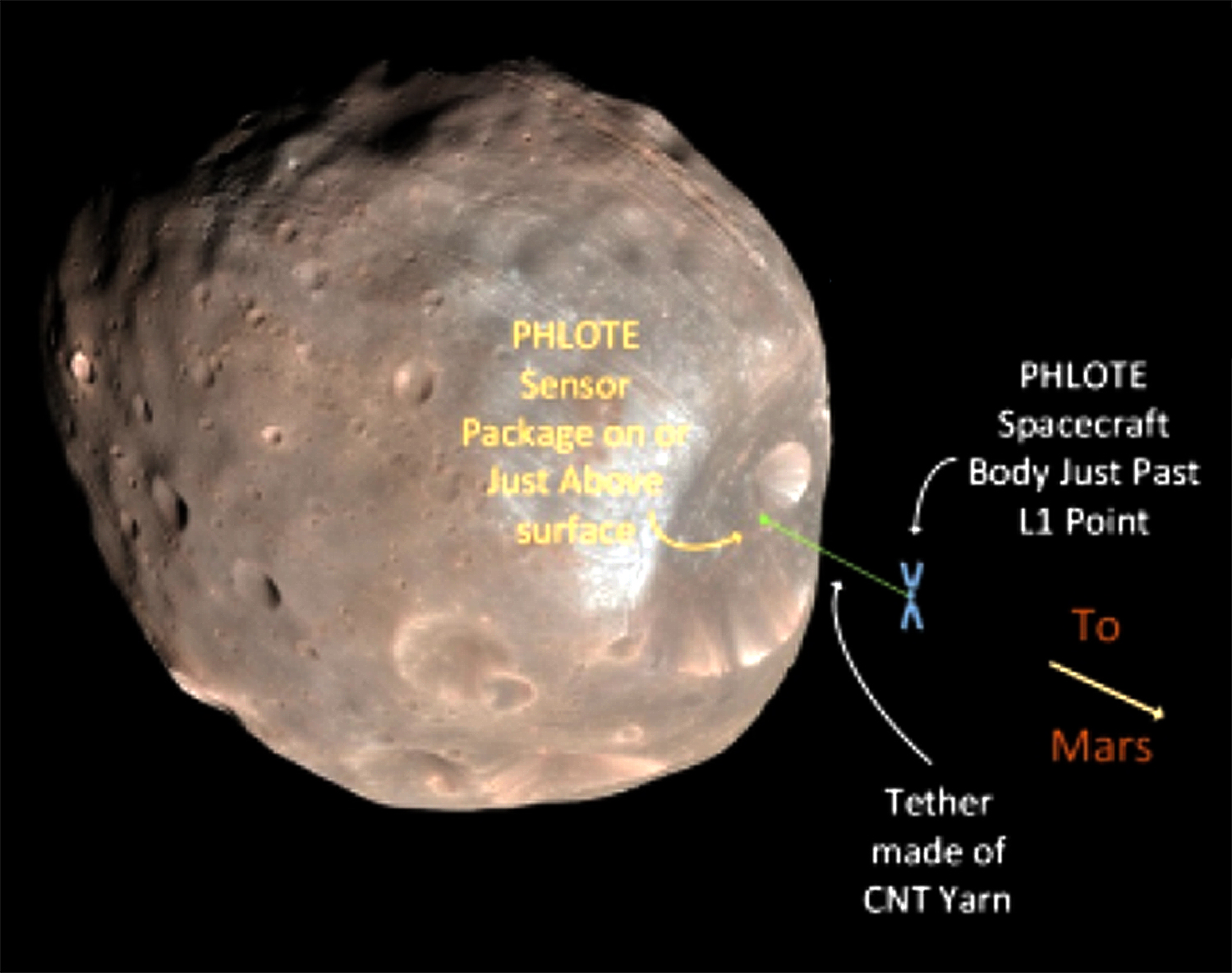Kevin Kempton
NASA Langley Research Center
Description
A sensor package that “floats” just above the surface of Phobos, suspended by a tether from a small spacecraft operating at the Mars/Phobos Lagrange 1 (L1) Point would offer exciting opportunities for science (SMD), for human exploration (HEOMD) and for advancements in space technology (STMD). Detailed information on the Martian moon Phobos is limited even though it is considered an important destination for near term human exploration. A PHLOTE spacecraft would perform fixed point station keeping at the Mars/Phobos L1 point to allow a tethered sensor package to “float” just above the moon’s surface and also park instruments on the surface for in situ science measurements. This can include ground penetrating radar for subsurface composition measurements to determine how thick the layer of fine grained regolith is for future landings. Other key instruments would be dosimeters for understanding the radiation environments for future human missions, cameras, and a spectrometer for surface mineral analysis. If deployed after a human landing, a PHLOTE spacecraft could provide a constant “eye in the sky” for ground controllers to monitor mission deployments and operational activities. The PHLOTE mission concept has only now become feasible due to recent technology advances, many of which have been supported by NASA’s STMD. Key technologies that make this mission concept feasible include: The Navigation Doppler Lidar (NDL) Sensor for the providing precise spacecraft position and rate knowledge relative to Phobos. This high precision is needed to maintain position at the L1 point; Carbon Nanotube (CNT) braided yarns for a structurally strong tether that doubles as a power and data conduit, Ultralightweight solar arrays, and highly efficient electrospray micro-propulsion thrusters for long term “hover mode” station keeping.
The Martian Moon Phobos offers a key waypoint toward enabling human surface landings on Mars. In particular Stickney Crater, which always faces Mars due to Phobos’ synchronous rotation, provides an excellent stepping stone destination as a precursor to a human Mars landing. There is very limited information on the composition and the environments at Stickney Crater on Phobos. Since Phobos has a composition similar to carbonaceous chondrite meteorites, it is believed that it could provide minerals that can be used for In Situ Resource Utilization (ISRU) to recover key elements such as Oxygen for use as return trip propellant. The mission concept below would answer many of these questions as well as provide TRL advancement in key technology areas for human exploration.
This mission concept is a synthesis of new technologies that would provide a unique platform for multiple sensors directed at Phobos as well as Mars. Since the Mars/Phobos L1 point is only ~3.1 km from the surface of Phobos, the PHLOTE tether length only needs to be a few kilometers long. A tether configuration with its Center of Gravity at the Mars/Phobos L1 point can place a sensor package on the moon’s surface or float it just above. Due to Phobos’ very low gravity, the tether will be under very low tensile loads.
Using a longer tether, this concept can be similarly used for other missions such as Mars/Deimos or at the Pluto/Charon L1 point where both bodies are tidally locked which means a PHLOTE spacecraft with a much longer tether could descend into Pluto’s tenuous atmosphere and sample its chemistry at all elevations unlike a traditional probe.
If selected, a feasibility study for the Phobos L1 Operational Tether Experiment (PHLOTE) mission would be performed that will define the PHLOTE mission, determine the technology needs and assess the technology readiness. The study would also model the system, identify risks, as well as explore new science opportunities that could be done with this unique sensor platform.
2017 Phase I and Phase II Selections































